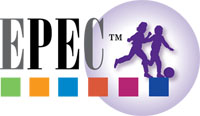Ball Control: Feet Lesson 1 Second Grade
This lesson introduces the instep kick and foot trapping skills. Cardiovascular endurance and agility are enhanced through age-appropriate exercises and working with others is emphasized.
This lesson introduces the instep kick and foot trapping skills. Cardiovascular endurance and agility are enhanced through age-appropriate exercises and working with others is emphasized.
This lesson introduces the instep kick and foot trapping skills. Cardiovascular endurance and agility are enhanced through age-appropriate exercises and working with others is emphasized.
This lesson introduces the instep kick and foot trapping skills. Cardiovascular endurance and agility are enhanced through age-appropriate exercises and working with others is emphasized.
Focus: In an age-appropriate manner, this lesson introduces the concept of physical literacy which, as outlined by SHAPE America, is the goal of physical education. This occurs during an exploration of movement fundamentals (locomotor, balance, and object control skills) where students are introduced to the “why” of moving, which is to promote joy, challenge, self-expression, and health enhancement. During the exploration of movement fundamentals (FUN-damentals), students are introduced to an initial set of PE classroom protocols, including safe moving in the activity area.
Focus: This lesson focuses on partner/team cooperation and team/individual challenges. It incorporates previously learned skills through use in games, team relay races, and skill challenges. A review of locomotor skills and balance is incorporated into the lesson.
Focus: This lesson focuses on team cooperation and team/individual challenge. It incorporates previously learned skills, including object control skills, through use in games, team relay races and skill stations.
Focus: This lesson reviews the concept of physical literacy which, as outlined by SHAPE America, is the goal of physical education. This occurs during an exploration of age-appropriate movement fundamentals (locomotor, balance, and object control skills) where students are introduced to the “why” of moving—to promote joy, challenge, self-expression, and health enhancement. Students are introduced to an initial set of PE classroom protocols, including safe moving in the activity area.
Focus: This lesson reviews the concept of physical literacy which, as outlined by SHAPE America, is the goal of physical education. This occurs during an exploration of age-appropriate movement fundamentals (locomotor, balance, and object control skills) where students are introduced to the “why” of moving—to promote joy, challenge, self-expression, and health enhancement. Students are introduced to an initial set of PE classroom protocols, including safe moving in the activity area.
Focus: This lesson reviews the concept of physical literacy which, as outlined by SHAPE America, is the goal of physical education. This occurs during an exploration of age-appropriate movement fundamentals (locomotor, balance, and object control skills) where students are introduced to the “why” of moving—to promote joy, challenge, self-expression, and health enhancement. Students are introduced to an initial set of PE classroom protocols, including safe moving in the activity area.
© 2025 Michigan Fitness Foundation
Important: epecforlife.org retires on October 10, 2025. Current subscribers will receive a Box Hub invite from noreply@box.com for continued access to materials for the remainder of their subscription; please create or use a Box account and save that email as your direct link.
Explore the new K–5 curriculum at epecplay.org; Preschool, 6–8, and 9–12 are in planning and development stages for future expansion.
Test
To have taxes removed from your order, you will first need to create an account. During that process, you can send a copy of your tax-exempt certificate.
Already have an account but never submitted your tax-exempt certificate? Send tax-exempt certificate now
